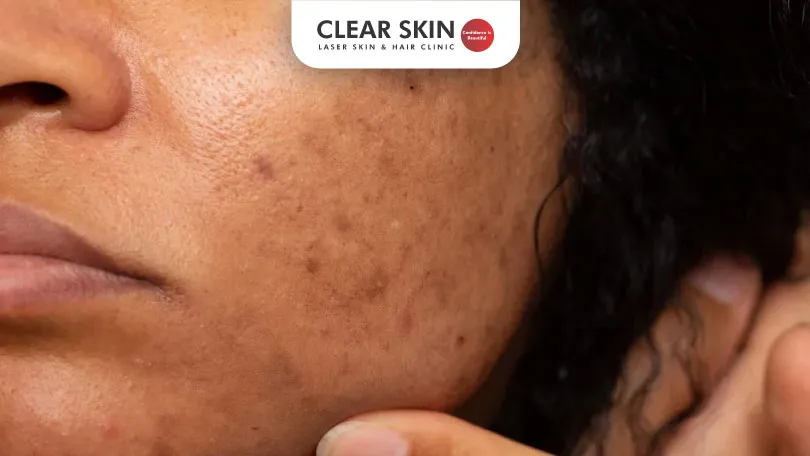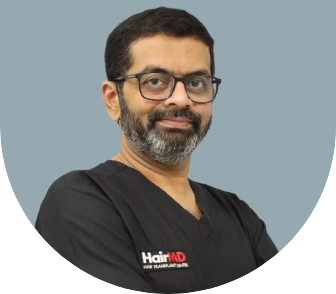Best 3 Treatments for Dark Spots after Acne
Reviewed By: ![]() Dr. Dhananjay Chavan
Dr. Dhananjay Chavan
Updated on: 21st March, 2024

Acne can be a temporary nuisance, but the marks it leaves behind, can linger, affecting skin clarity and confidence. Today, there are numerous advanced solutions for this problem. In this blog, we will take a look at multiple treatment options for dark spots after acne that can help you battle them.
Note: The information available in this blog is for informational purposes only. Make sure you consult your dermatologists or our experts before getting started.
Table Of Content
-
How Do Post-Acne Dark Spots Occur?
-
Duration and Persistence of Dark Spots
-
Treatments to Post-Acne Dark Spots
- Comprehensive Routine Care
-
Brightening Ingredients
-
Sun Protection
- Conclusion
How Do Post-Acne Dark Spots Occur?
The length of time these dark spots remain can vary widely, often lingering for months or even years. Factors such as skin type, the severity of the inflammation, treatment effectiveness, and sun exposure significantly influence their persistence. Understanding these factors is essential in choosing the right approach to fade and eventually eliminate these marks.
Duration and Persistence of Dark Spots
Dry skin can reap the most benefits from the use of face oil. Use your hydrating serum or moisturizer and follow it up with a few drops of oil. The face oil will act as an emollient and seal and prevent any water loss, resulting in moist plump skin.
Best face oils for dry skin: Argan, Olive, Sunflower, Jojoba, Maracujs, Coconut
Treatments to Post-Acne Dark Spots
Addressing post-acne marks requires a two-pronged approach: clinical treatments to directly target and reduce pigmentation and a dedicated skincare routine to support skin health and prevent further damage.
3 Treatments Options
1: Chemical Peel
Chemical peels stand out as a go-to method for diminishing the visibility of post-acne dark spots. This treatment involves the application of a specialized chemical solution to the skin, leading to the exfoliation of the outermost layer of dead skin cells.
This exfoliation is crucial, as it promotes the emergence of new skin cells, thereby accelerating the skin’s natural renewal process. As a result, patients can observe a noticeable lightening of dark spots, along enhancements in the skin’s overall texture and a boost in radiance.
The versatility of Chemical peels lies in their ability to be customized. Depending on the individual’s skin sensitivity and the intensity of the pigmentation, dermatologists can adjust the depth of the peel. This customization ensures that each patient receives a treatment that is both effective and suited to their specific needs.
From light peels, which target the very surface of the skin and require minimal downtime, to deeper peels that reach further into the skin for more significant results, the range of options allows for personalized care. Regular sessions might be necessary to achieve optimal outcomes, with the skin’s appearance continuously improving with each treatment.
2: Laser Therapies & Treatments
Laser therapy represents a cutting-edge approach in the battle against post-acne dark spots. Utilizing focused light energy, this treatment zeroes in on melanin deposits within the skin.
The laser energy is absorbed by the pigmented areas, causing the melanin to break down and gradually fade. This process significantly diminishes the appearance of dark spots and contributes to a more even and uniform skin tone.
The precision of laser therapy is one of its most significant advantages. Dermatologists conduct thorough evaluations to determine the most appropriate laser type and settings for each patient, considering factors such as skin type, color, and the severity of the hyperpigmentation. This tailored approach helps maximize the effectiveness of the treatment while minimizing potential side effects.
Laser treatments can provide dramatic improvements in the reduction of hyperpigmentation, enhancing the skin’s overall tone and texture. Some patients might experience a degree of discomfort during the procedure.
There may be a short period of downtime as the skin heals. However, many find the results—smoother, clearer skin—well worth it.
3: Microneedling
Microneedling has gained popularity as an innovative and effective treatment for reducing post-acne marks. This procedure involves the use of a device equipped with fine needles to create micro-injuries in the skin. These tiny punctures trigger the body’s natural healing mechanisms, including a surge in collagen production.
Collagen is essential for skin repair and rejuvenation, helping to not only reduce the appearance of dark spots but also improve the overall texture of the skin. One of the key benefits of microneedling is its ability to promote skin regeneration from within. As the skin heals from the micro-injuries, it becomes firmer, smoother, and more even-toned.
The treatment is relatively minimally invasive and can be adjusted in intensity to suit different skin types and concerns, making it a versatile option for a wide range of patients.
Following microneedling, patients may notice some redness and swelling, akin to a mild sunburn, but these side effects typically subside within a few days. For the best results, a series of treatments is often recommended, with improvements becoming more apparent after each session.
Comprehensive Routine Care
A comprehensive daily skincare routine is foundational in the battle against post-acne dark spots and helps maintain the results of any treatment. Effective skincare routines emphasize prevention, protection, and correction.
Brightening Ingredients
Adding products with specific ingredients known for their brightening and pigmentation-reducing properties is crucial.
Here’s a closer look at each recommended ingredient:
1. Vitamin C
A powerhouse antioxidant, vitamin C not only helps in reducing the appearance of dark spots but also protects the skin from environmental damage by neutralizing free radicals. It inhibits the enzyme tyrosinase, reducing melanin production. For best results, look for serums or moisturizers with stable forms of vitamin C, such as L-ascorbic acid, at concentrations of 10–20%.
2. Niacinamide
Also known as vitamin B3, niacinamide works by decreasing melanin transfer to skin cells, effectively fading hyperpigmentation. It’s also renowned for its anti-inflammatory properties, which can reduce redness and irritation, making it ideal for sensitive skin types. Products containing 2-5% niacinamide are effective for daily use and can be found in serums, moisturizers, and toners.
3. Alpha Arbutin
A more stable and effective form of the skin-brightening agent arbutin, alpha arbutin works by inhibiting tyrosinase activity, thus preventing the formation of melanin. It’s particularly effective in combination with other ingredients like vitamin C and can be used twice daily for gradual but visible results.
These ingredients are not a magic wand. It can take several weeks to notice a reduction in pigmentation, and consistent use is crucial for maintaining results. Most importantly, consult your dermatologist before getting started.
Sun Protection
Sun protection is arguably the most important step in any skincare routine, especially when dealing with post-acne dark spots. UV exposure can exacerbate hyperpigmentation, undoing the effects of treatments and brightening ingredients.
Here’s how to ensure effective protection:
1. Use a Broad-Spectrum Sunscreen: Choose a broad-spectrum sunscreen with an SPF of 30 or higher. Broad-spectrum products protect against both UVA (aging) and UVB (burning) rays. Apply generously to all exposed skin areas every morning, even on cloudy days or when indoors, as UVA rays can penetrate windows.
2. Reapplication: Sunscreen should be reapplied every two hours when in direct sunlight. For daily, mostly indoor activities, applying once in the morning may be sufficient. However, if you’re spending time outside or by windows, reapplication is necessary to maintain protection.
3. Additional Measures: Wearing protective clothing, seeking shade, and avoiding peak sun hours (10 a.m. to 4 p.m.) can further reduce your skin’s exposure to harmful UV rays.
Do You Know?
Roughly 250 Patients Are Treated
Everyday By These Dermatologists
(You are one click away from flawless skin)
Meet Our Dermatologist!
Conclusion
The journey to clear, blemish-free skin requires patience, consistency, and the right combination of treatments and skincare. By understanding the nature of post-acne dark spots and exploring the most effective solutions, you can significantly improve your skin’s appearance and health. But remember, its always important to consult a dermatologist before starting any treatment plan. Only a certified dermatologist can ensure your treatment plans are safe and bear results.
Further Reading
How to Avoid Acne in Monsoons?
Avoid acne in monsoons with a gentle skincare routine, diet tips, and hydration. Get expert advice to manage breakouts and keep your skin clear and healthy.
Does Makeup Cause Acne-Prone Skin?
Worried about breakouts from using makeup? Does makeup cause acne for you? Learn the safe ways to apply makeup for acne-prone skin.
Morning Skin Care Routine for Glowing Skin
Clear Skin Clinic, led by top dermatologists, shares the ideal morning skincare routine to help you achieve a radiant complexion naturally and effectively.
Monsoon Skin Care Tips for Radiant, Healthy Skin
Clear Skin Clinic, led by top dermatologists, shares the ideal morning skincare routine to help you achieve a radiant complexion naturally and effectively.
Have thoughts? Please let us know
We are committed not only to treating you, but also educating you.





